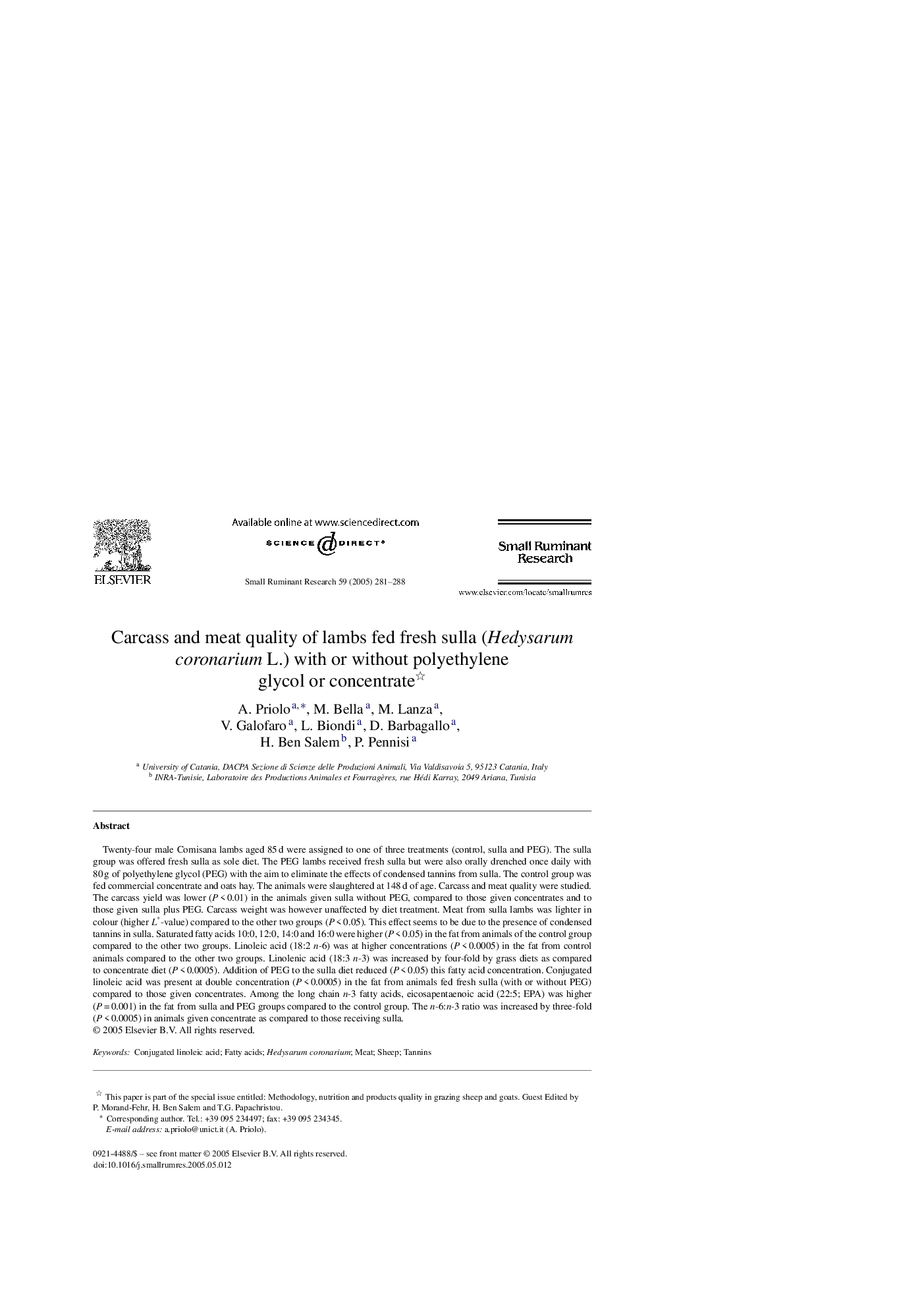| کد مقاله | کد نشریه | سال انتشار | مقاله انگلیسی | نسخه تمام متن |
|---|---|---|---|---|
| 8986879 | 1554434 | 2005 | 8 صفحه PDF | دانلود رایگان |
عنوان انگلیسی مقاله ISI
Carcass and meat quality of lambs fed fresh sulla (Hedysarum coronarium L.) with or without polyethylene glycol or concentrate
دانلود مقاله + سفارش ترجمه
دانلود مقاله ISI انگلیسی
رایگان برای ایرانیان
کلمات کلیدی
موضوعات مرتبط
علوم زیستی و بیوفناوری
علوم کشاورزی و بیولوژیک
علوم دامی و جانورشناسی
پیش نمایش صفحه اول مقاله

چکیده انگلیسی
Twenty-four male Comisana lambs aged 85Â d were assigned to one of three treatments (control, sulla and PEG). The sulla group was offered fresh sulla as sole diet. The PEG lambs received fresh sulla but were also orally drenched once daily with 80Â g of polyethylene glycol (PEG) with the aim to eliminate the effects of condensed tannins from sulla. The control group was fed commercial concentrate and oats hay. The animals were slaughtered at 148Â d of age. Carcass and meat quality were studied. The carcass yield was lower (PÂ <Â 0.01) in the animals given sulla without PEG, compared to those given concentrates and to those given sulla plus PEG. Carcass weight was however unaffected by diet treatment. Meat from sulla lambs was lighter in colour (higher L*-value) compared to the other two groups (PÂ <Â 0.05). This effect seems to be due to the presence of condensed tannins in sulla. Saturated fatty acids 10:0, 12:0, 14:0 and 16:0 were higher (PÂ <Â 0.05) in the fat from animals of the control group compared to the other two groups. Linoleic acid (18:2 n-6) was at higher concentrations (PÂ <Â 0.0005) in the fat from control animals compared to the other two groups. Linolenic acid (18:3 n-3) was increased by four-fold by grass diets as compared to concentrate diet (PÂ <Â 0.0005). Addition of PEG to the sulla diet reduced (PÂ <Â 0.05) this fatty acid concentration. Conjugated linoleic acid was present at double concentration (PÂ <Â 0.0005) in the fat from animals fed fresh sulla (with or without PEG) compared to those given concentrates. Among the long chain n-3 fatty acids, eicosapentaenoic acid (22:5; EPA) was higher (PÂ =Â 0.001) in the fat from sulla and PEG groups compared to the control group. The n-6:n-3 ratio was increased by three-fold (PÂ <Â 0.0005) in animals given concentrate as compared to those receiving sulla.
ناشر
Database: Elsevier - ScienceDirect (ساینس دایرکت)
Journal: Small Ruminant Research - Volume 59, Issues 2â3, August 2005, Pages 281-288
Journal: Small Ruminant Research - Volume 59, Issues 2â3, August 2005, Pages 281-288
نویسندگان
A. Priolo, M. Bella, M. Lanza, V. Galofaro, L. Biondi, D. Barbagallo, H. Ben Salem, P. Pennisi,